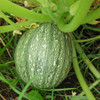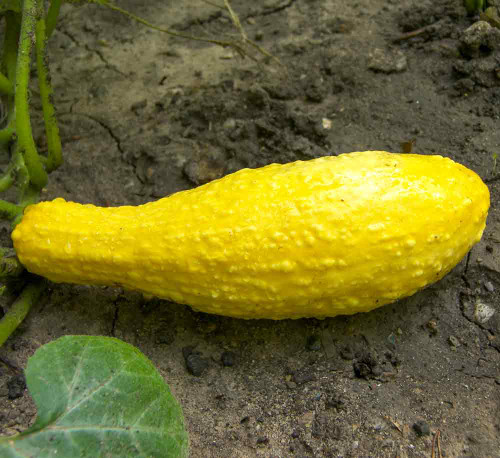Description
Tonda Nizza Summer Squash - “Round of Nice”
This centuries-old round zucchini is sought after in summertime in both the Provence region in southern France and throughout middle and northern Italy. It is highly valued – both regions claim to be where it originated, even though the Italians recognize their name translates as “round of Nice” zucchini, as in Nice in southern France.
You’ll never see these in the supermarket, and only rarely in farmer’s markets or from specialty growers with a premium price attached, yet it is easy to grow in your garden. Replace your typical green zucchini with these and you'll discover a new world of flavor.
It is sometimes called “Baby Round Zucchini” in seed catalogs but is also known as Tondo Chiaro di Nizza Zucchini, Zucchini Tondo Nizza, and Ronde De Nice.
Intro
Tonda Nizza is an early maturing, savory “bush” variety summer squash that remains quite compact instead of sprawling and is great for growing in tight spaces or raised beds. Expect prolific harvests of medium-sized light green round fruits with very thin skin and an excellent flavor.
The zucchini are most flavorful when young, the size of a golf ball to an orange. This is probably the most widespread variety of round zucchini found today. The skin is light green rather than dark green and is very thin so handle carefully.
Harvest fruit when no larger than a grapefruit for continuous production. Smaller-sized fruit are more tender than larger, with most people preferring the baseball size for its combination of tender, edible skin and fine texture and flavor that isn’t lost when cooked.
The flavor is best when harvested, taken inside and washed, then cooked and eaten that evening.
History
Native to North America, summer squash is among the oldest known cultivated crops - archeological evidence dates the domestication to around 7,000 to 10,000 years ago in central Mexico.
Ethnobotanists theorize the native range of domesticated summer squash – Cucurbita pepo – stretched from Central America, through Mexico, along the Eastern Seaboard north to Quebec. The first cultivated squash were likely gourds, grown for their outer shells as storage and carrying vessels. Seeds, as a calorie-dense, storable food were possibly the next phase of selection, eventually followed by a focus on the flesh of mature fruits, much like the pumpkin and winter squash we know today.
The final phase was probably a careful and focused breeding and selection process for a squash whose immature fruits were fine-textured, mild and edible. This was most likely the origination of the calabacita, the Mexican name meaning “little squash” for zucchini-like immature squash that we know and love today.
Ancestors of the modern-day zucchini strains likely accompanied Columbus when he returned from his Caribbean voyages, or soon afterward on subsequent return trips.
Tonda Nizza appears to be Vilmorin’s “Courge de Nice a fruit rond.” The Vilmorin Andrieux catalog of 1902 says of it, “en Provence, on la consomme demi-formee, au printemps”; in Provence, it is eaten young in spring.
Uses
Summer squash are amazingly versatile in the kitchen, far beyond the typical salad filler or zucchini bread ingredient, and round squash are even more so. They are great for grilling, stuffing, frying, or using in parmigiana instead of eggplant.
Tonda Nizza is perfect for stuffing. Try spaghetti with a zucchini and saffron cream, twirled into a bundle and served directly inside the roasted, hollowed fruit for an easy, fresh and elegant summer dinner.
Excess male flowers can be filled with cheese, dipped in Tempura batter, and deep-fried as an appetizer or snack.
Stuffing a round summer squash is easy – blanch whole in boiling water for 5-6 minutes, remove the cap on top and scoop the insides out with a spoon. Roasting whole in the oven or on the grill for 10-15 minutes with medium heat is another easy way to prep them for stuffing, with the grill adding a delicious smoky flavor.
Renown Italian-American cook Marcella Hazan loved exploring the delicious potential of hollowed zucchini, finding a diverse number of ingredients that go well with it: ground pork, prosciutto and pancetta, ground lamb and rice, or completely vegetarian approaches such as onions, tomatoes, and herbs.
Companion Planting
All summer squash are aggressively growing plants that look wonderful with cosmos, zinnias, and sunflowers.
Does well with beans, borage, fennel, nasturtium, sweet corn, and tansy.
Keep away from potatoes, rosemary, rue, sage, and thyme, as they are antagonistic towards each other.
Growing Tip
All varieties of Cucurbita pepo are pollinated by bees, so planting pollinator-attracting flowers among summer squash helps ensure a good harvest.
Sow 5 seeds per hill, 4’ apart. Thin to best 2-3 plants. Squash seeds dislike cold soil. It’s better to wait until the soil is warm to the touch first thing in the morning to plant the seeds.
Well-irrigated, fertile soil is essential for the best production and flavor. Mulching heavily around your plants will also help with weed suppression and moisture retention.
Water around the plants, avoiding overhead watering, as wet leaves will attract diseases like mildew, and beads of water act as a magnifying glass in the sun, burning the leaves. Remove weeds often to keep them from stealing nutrients from the squash.
Grow in good, fertile soil with full sun and you’ll have few problems. One common problem is powdery mildew on the leaves that shows up in mid-summer as grey patches on the leaves and stems, looking just like a dull white or light grey powder. It’s the result of excess moisture, usually by watering overhead where leaves and stems stay wet.
A drip system is best, water early in the cool morning, and only wet the soil around the plants. Leave space between plants to improve air circulation. Remove badly affected leaves by cutting close to the plant, making sure to throw them in the garbage and not the compost which continues the problem.
Harvest Tip
Harvest summer squash early in the morning for firmer flesh, but don’t tear the fruit from the vine, as it will cause the fruit to lose moisture quickly and invite disease into the plant.
Instead, cut the fruit with a sharp knife or garden shears.
Learn More
From the soil to the seed to the food you eat - we'll help you grow your best garden!
2 Reviews
-
Not my favorite
This grew and produced very well for me all summer long. Very fast and abundant. What is golf ball in size today is a softball in size the next. I like them better at the golf ball stage. The larger ones tended to be spongy on the inside and when cooked give up a lot of liquid, so it didn't work so well when breaded. I am still working on my garden soil so I will try them again and see if they come out any different next year.
-
Best we ever had
Love the tonda nizza. If you love fried zucchini this is the plant. You can even freeze it and fry them back up and they're perfect.















